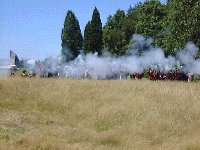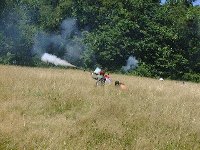



Native American tribes staged an uprising under Pontiac, an Ottawa chief, during the spring of 1763. This uprising became known as Pontiac's War. The Native Americans were tired of the British breaking promises to keep European settlers out of their territories west of the Alleghenies. The uprising was well-organized and forts from Michigan to Pennsylvania fell to their attacks. Only Fort Detroit and Fort Pitt held out on the frontier, and the Native Americans placed them under siege. Colonel Henry Bouquet led a force of 400 British soldiers to break the siege of Fort Pitt. They left Carlisle, Pennsylvania on July 18, 1763 and headed west for Fort Pitt. A group of between 99 (according to Native Americans) and 400 (Bouquet's estimate) Seneca, Delaware and Shawnee ambused his column about a mile from where they had planned to camp at Bushy Run (today, the town of Harrison City is located near that spot, southeast of Pittsburgh). The Battle of Bushy Run took place on August 5 and 6, 1763. The battle was touch and go until Bouquet devised a strategy to make the Native Americans think his forces were retreating. The center of his line feigned a retreat, causing the Native Americans to attack in force. The center, did not retreat, but moved around the hill and flanked the Native Americans. They attacked them from the side and routed them. Bouquet's casualties were 50 men killed and 60 wounded. An unknown number of Native Americans were killed. Bouquet then marched on to Fort Pitt and releaved the siege. The Battle of Bushy Run turned the tide against the Native Americans. Bouquet led a force of British into Ohio in 1764 and the Native Americans ended the war by signing a treaty at the Forks of the Muskingum [River].
Bushy Run Battlefield is now a Pennsylvania State Historical Park. Reenactments of the Battle of Bushy Run are held annually on the first weekend of August. The following are links to photographs made during the reenactment held on August 3, 1998.
According to Bouquet, the Battle on Edge Hill was a series of charges and withdrawals back to their perimiter at the top of Edge Hill prior to the flanking movement. Flour bags that were part of the supplies they were bringing to Fort Pitt were piled into an "fort." Wounded were placed behind the flour bags. Only the top of the hill would have been grassland at the time of the original battle. However, the open field lets the visitors more clearly see the battle reenactment. The next pictures show the advances and retreats back up the hill by the British and Native Americans. The flanking movement is represented in the last two pictures.